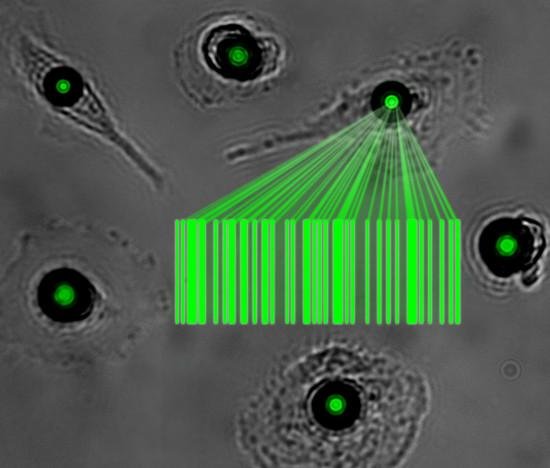Researchers have created micro-laser emitting human cells which could improve cancer research. Photo by Malte Gather/St. Andrews
ST. ANDREWS, Scotland, July 23 (UPI) -- In an effort to improve their cancer-fighting skills, researchers at the University of St. Andrews, in Scotland, have managed to turn human blood cells into micro-lasers.
The process works by coaxing white blood cells in a petri dish to swallow, or absorb, a resonant cavity, or micro resonator -- a tiny bubble of sorts. Inside the bubble is a light-emitting protein, the same protein that gives jellyfish their green fluorescence.
Once inside the cell, the proteins are excited by a laser. The cavity, or bubble, has magnifying effect, significantly boosting the proteins' luminosity. Right now, the scientists have only converted cells into a micro-laser inside a petri dish. But they believe the cells can be safely and successfully introduced into the body.
The technology isn't entirely new, but until now, researchers haven't been able to create a micro resonator small enough to fit entirely inside a human cell. Once excited, the cell-encapsulated lasers can shine for several days.
If they're able to introduce the glow-in-the-dark cells to human test subjects, researchers believe they can ultimately watch the growth of tumors and behavior of cancer cells in real time.
"The ability to track the movement of large number of cells will widen our understanding of a number of important processes in biology," lead researcher Malte Gather, a St. Andrews physics professor who collaborated with immunologists in the University's School of Medicine, explained in a press release.
"For instance being able to see where and when circulating tumour cells invade healthy tissue," Gather continued, "can provide insight into how cancers spread in the body which would allow scientists to develop more targeted therapies in the future."
Researchers say they can even "barcode" each light-emitting cell, inserting a light-based signature that can be distinguished among thousands of cells.
Gather and his colleagues shared their latest successes in the journal Nano Letters.















